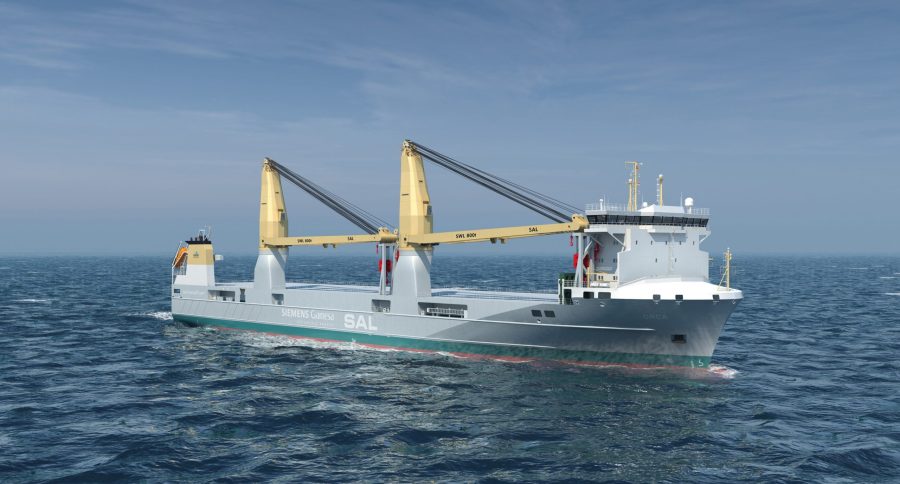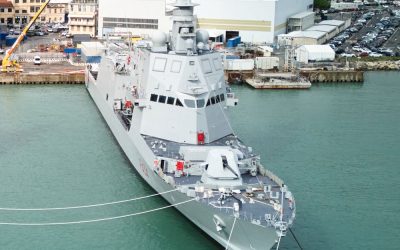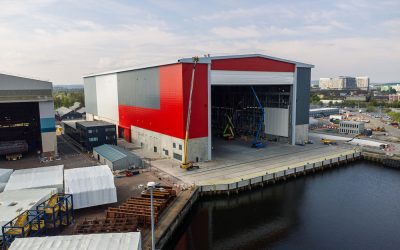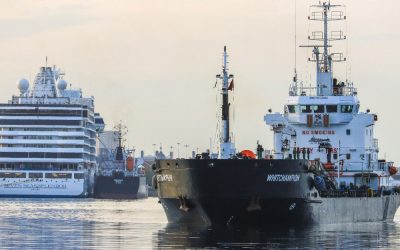Wuhu Shipyard’s series of Orca class vessels for Germany’s SAL Heavy Lift and Jumbo Shipping will set new benchmarks in efficiency, it is claimed. Daniel Johnson reports.
Currently the second-largest renewable source of electricity following hydropower, wind power is one of the cornerstones of the green energy transition. Offshore wind in particular holds enormous promise to tackle the climate crises – including, according to some studies, the potential capacity to power nearly every home and business on the planet. Installed global capacity is expected to reach 380GW by 2030, up from 57GW in 2021, and as the industry prepares for the massive and necessary build out of offshore wind farms to reach this target, it also has its sights set on driving down the environmental footprint of their installation.
Earlier this year, work began at Wuhu Shipyard in China on a new generation of ultra-efficient heavy lift vessels slated to be the new yardstick in terms of emissions and technical capabilities. The two Orca class vessels under construction form part of a fleet of four ships being built in Wuhu for Germany-based SAL Heavy Lift, one of the leading maritime heavy lift and project cargo carriers, and joint venture partner Jumbo Shipping of the Netherlands, another heavyweight in the sector.
Scheduled for delivery in July 2024, the first pair of ships will be exclusively involved in the transportation of offshore wind turbine components in a long-term commitment with Spanish-German wind engineering company Siemens Gamesa Renewable Energy. The two additional sister vessels will enter the premium heavy lift shipping market to serve the clients of the Jumbo-SAL-Alliance in the first half of 2025.
“The Orca vessels are setting new standards in global heavy lift shipping. They represent the new benchmark both in terms of their technical capabilities and modern climate-friendly propulsion systems,” says Martin Harren, owner and CEO of SAL Heavy Lift. “The ships will be the most efficient vessels in their class with consumption and emission figures far superior to any existing heavy lift vessel today.”
Harren adds that the vessels were developed in-house in close co-operation with Jumbo Shipping and that the partners also conducted discussions with Siemens Gamesa Renewable Energy from the very beginning of the newbuild programme to develop the capabilities of the new vessels.
The Orca class measure 149.9m x 27.2m and provide a capacity of 14,600dwt. According to SAL Heavy Lift, despite their compact outer dimensions, the vessels have a box-shaped single cargo hold with the largest dimensions in its class. Provided the hatch covers with a capacity of 10tonnes/m2 are utilised for stowing super-heavy deck cargoes, such as 3,000tonne cable carousels, the vessels can accommodate over-height cargo in the hold and sail with open hatch covers up to full scantling draft.
Ice class notation 1A, a Polar Code certification and the reduced design temperature of the hull and equipment allow the ships to safely operate in cold conditions.
Jakob Christiansen, head of retrofit and newbuilding R&D at SAL Heavy Lift, comments: “We developed and optimised various vessel details, especially in relation to the hull form and propulsion system, in close co-operation with the renowned Naval Architecture faculty at the Hamburg University of Technology. Tank performance tests revealed that we have created one of the world’s most efficient hull forms for a vessel of this size – outmatching all existing heavy lift and MPP vessels.”
Hybrid propulsion system
In addition to the optimised hull design, the Orca class vessels will have an innovative hybrid propulsion system supplied by Finnish technology group Wärtsilä that will minimise CO2 emissions.
The system will feature a variable-speed Wärtsilä 32 methanol dual-fuel main engine, making the ships among the first to be prepared to operate on methanol and, according to Wärtsilä, also the first methanol capable ships to employ a variable-speed main engine. If green methanol becomes available in key ports as anticipated towards the end of the decade, the Jumbo-SAL-Alliance will be able to offer its customers carbon-neutral transport solutions.
The hybrid system also includes energy storage, a PTO/PTI generator and motor, a multidrive converter, and the Wärtsilä energy management system for controlling and optimising the hybrid operations. The energy storage system (ESS) will be based on lithium-titanium-oxide (LTO) batteries, which Wärtsilä says can handle higher amounts of deep cycles than normal lithium-ion-based systems. It is anticipated that the ESS will significantly reduce fuel consumption and minimise engine load fluctuations through peak shaving during operations in rough seas.
At a service speed of 15knots, SAL Heavy Lift expects the Orca class vessels to consume significantly less than 20tonnes of fuel oil per day – similar to far smaller-sized and geared MPP vessels. Alternatively, the company says, the vessels will be able to trade at a slow, ultra-efficient speed of 10knots at 6tonnes while still being able to reach a maximum speed of 18.5knots for pressing deliveries – if a wind farm installation vessel is waiting for an urgent component delivery, for example.
For each vessel, Wärtsilä will also supply the gearbox, the controllable pitch propeller (CPP), the bow and stern thrusters, air shaft seals, as well as the sterntube and bearings.
Smart cranes
Two all-electric 800tonne Liebherr LS 800 E cranes specifically designed for this ship type can handle cargo items weighting up to 1,600tonnes in tandem. Apart from fulfilling the demanding operational requirements and different cargo scenarios, the cranes enable significant savings in smart interaction with the innovations on the ship side, according to SAL Heavy Lift. The LS 800 E actively communicates with the ship’s energy management system and thus enables intelligent energy utilisation. Recovered energy is fed back into the ship’s ESS so that it can be released when energy consumption is high again. This leads to a noticeably reduced fuel consumption and a considerable reduction of CO2 emissions.
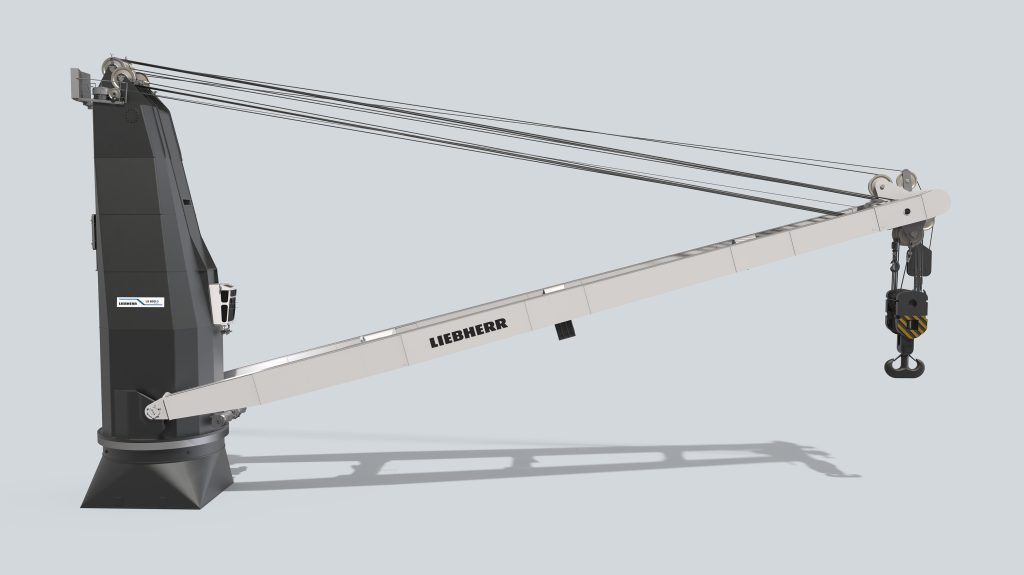
The all-electric LS 800 E has a lifting capacity of up to 800tonnes
The entire power electronics of the drive system are installed inside the cranes. This allows the limited space below deck to be used for other purposes and facilitates the integration of the crane into the ship’s design. The integration of the drive concept inside the crane also significantly increases the durability of the components, as they are protected from the weather. “The reliability of the cranes is extremely important for heavy lift vessels. They must function for the entire life of the vessel,” points out Harren.
And despite extremely high crane pedestals of more than 11m, the overall crane height and thereby the vessel’s air draft remains at just about 38m, making it possible for the vessel to enter strategically important ports worldwide.
Siemens Gamesa Renewable Energy reports that it is impressed with the flexibility these new vessels represent, noting that its business is a complex one, challenged by rapid globalisation as well as the increasing size and weight of turbine components.
“The Orcas meet several of the company’s anticipated medium- to long-term transportation challenges,” observes Christian Johansen, global commodity manager at Siemens Gamesa Renewable Energy, “and we see their ultra-efficient profile and carbon-neutral potential as a perfect fit with our aim of decarbonising our supply chain.”
Technical particulars
| Length | 149.90m (loa); 142.27m (lbp) |
| Breadth | 27.20m (moulded) |
| Moulded depth | 16.70m |
| Draught | 8.5m |
| Deadweight | 14,600t |
| Cargo gear | 2 x low noise, fully electric cranes; each 800t SWL (in combination 1,600t); auxiliary hoist 60t; sling hoist 10t, man-riding certified |
| Hatch cover | Pontoon type, heavy duty, floatable, quick acting spreader handled |
| Tweendeck cover | Pontoon type, water ballast-able, quick acting spreader handled, 4 adjustable heights |
| Number of holds | 1 |
| Dimension of hold | 107 x 18.5 x 13.3m |
| Volume of hold | 23,600m³ |
| Free deck space | 3,330m³ |
| Permissible deck loads acc. DNV STN-001
|
Weatherdeck 10t/m²; tweendeck 8t/m²; tanktop 18t/m² |
| Main engine | 1 x Wärtsilä 32 (methanol dual fuel) |
| Service speed | 15knots |
| Class notation | Ice class 1A (Finnish / Swedish), strengthened for heavy cargo |
